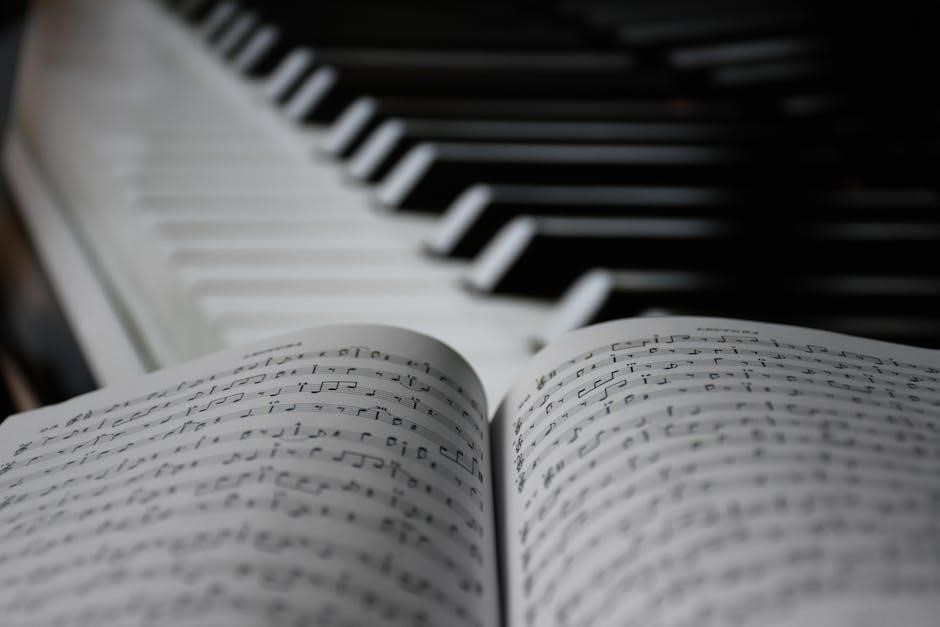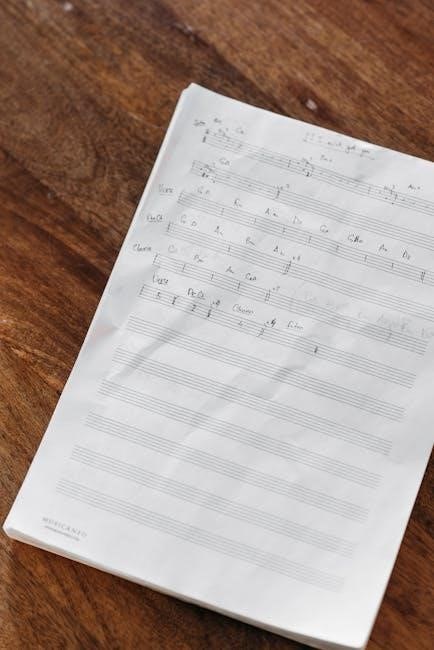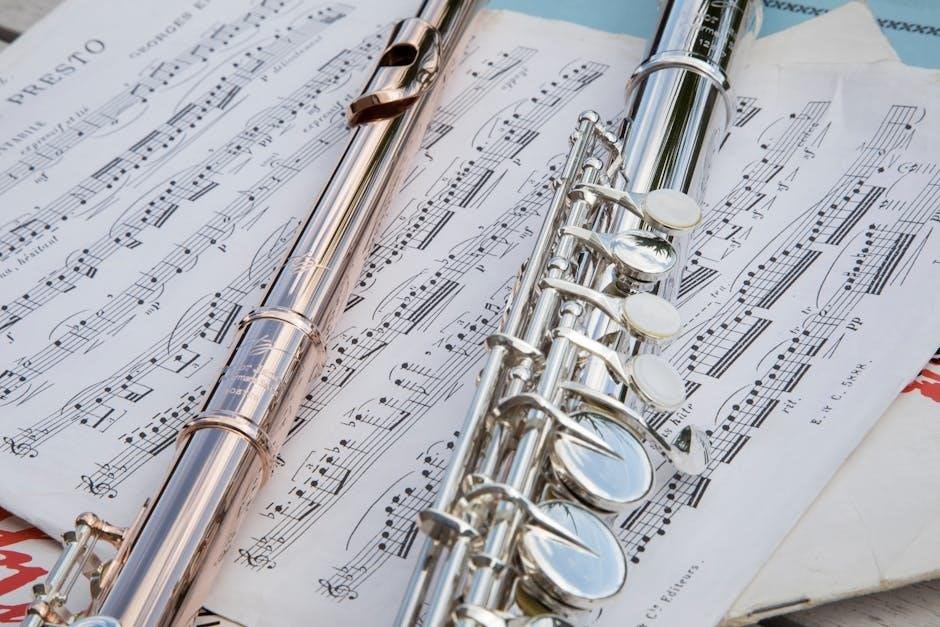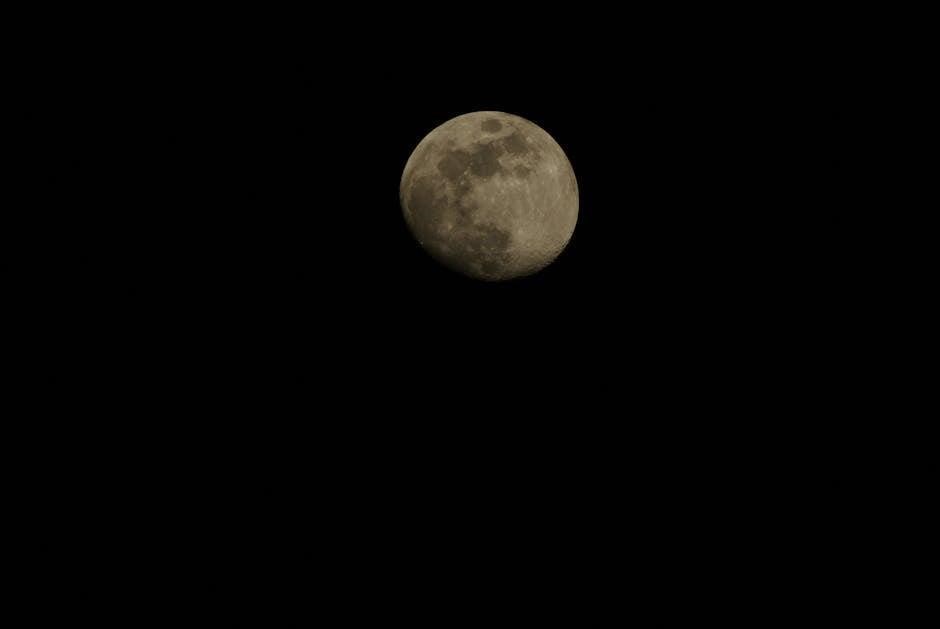The Moonlight Sonata, composed by Ludwig van Beethoven in 1801, is one of his most renowned works, known for its dreamy, evocative quality. Its official title is Piano Sonata No. 14 in C♯ minor, Op. 27, No. 2. This sonata is celebrated for its technical complexity and emotional depth, making it a favorite among pianists and music lovers alike. The sheet music, widely available in PDF format, offers both original and simplified arrangements, catering to pianists of all skill levels. Its enduring popularity has led to numerous adaptations and interpretations across various instruments and genres.
1.1 Historical Background
Beethoven composed the Moonlight Sonata in 1801, dedicating it to his pupil, Countess Julie “Giulietta” Guicciardi. It was published in 1802 as part of his innovative works that bridged the Classical and Romantic eras. The sonata is notable for its departure from traditional sonata form, embracing a more expressive and imaginative style. The name “Moonlight” was later coined by a critic, describing the first movement’s dreamy, flowing quality. This piece remains a cornerstone of piano repertoire, reflecting Beethoven’s evolving artistic vision and emotional depth. Its historical significance lies in its contribution to the transformation of classical music.
1.2 Popularity and Cultural Significance
The Moonlight Sonata is one of Beethoven’s most celebrated compositions, renowned for its haunting beauty and technical brilliance. Its popularity stems from its evocative first movement, which has captivated audiences worldwide. The sonata has transcended classical music, influencing various genres and appearing in films, literature, and advertisements. Its cultural significance is evident in its widespread recognition and the emotional connection it fosters. As a result, it remains a staple in piano repertoire, with its sheet music, particularly the first movement, being among the most downloaded and performed pieces. Its enduring appeal lies in its ability to evoke profound emotions and inspire musicians and listeners alike.
1.3 Structure and Composition
Beethoven’s Moonlight Sonata is structured as a three-movement piano sonata, labeled Quasi una fantasia, breaking traditional sonata form. The first movement, Adagio sostenuto, features a dreamy, flowing melody with arpeggiated chords. The second, Allegretto, is a lively, contrasting scherzo. The third, Presto agitato, is a dramatic, technically demanding finale. Composed in C♯ minor, the sonata showcases Beethoven’s innovative use of dynamics, tempo, and emotional expression. Its unique structure and technical challenges have made it a cornerstone of piano repertoire, with sheet music widely available for study and performance.

Sheet Music Availability
Moonlight Sonata sheet music is widely available in PDF format, offering both free and licensed versions. Beginners and advanced pianists can access arrangements tailored to their skill levels, ensuring accessibility for all.
2.1 Free Printable PDF Versions
Free printable PDF versions of the Moonlight Sonata are widely available online, offering convenient access to this iconic piece. Websites like the Mutopia Project and Sheet Music For Free provide high-quality, public domain sheet music, perfect for pianists of all levels. These versions often include fingerings and dynamic markings, making them ideal for practice and performance. Many arrangements cater to both beginners and advanced players, ensuring accessibility for everyone. Legal and free resources are plentiful, allowing musicians to download and print the Moonlight Sonata without cost or copyright concerns.
2.2 Beginner and Intermediate Arrangements
Beginner and intermediate pianists can explore simplified arrangements of the Moonlight Sonata that maintain its essence while reducing technical complexity. These versions often include fingerings and reduced tempos, making the piece more accessible. Websites like Sheet Music For Free and MuseScore offer tailored arrangements, ensuring that learners can progress at their own pace. Additionally, some resources provide step-by-step tutorials and practice guides, helping pianists master the sonata’s iconic melodies and harmonies. These adaptations are ideal for building confidence and skill before tackling the original composition.
2.3 Licensed and Public Domain Sources
The Moonlight Sonata is in the public domain, making its sheet music freely available without copyright restrictions. Websites like Mutopia Project and Sheet Music Archive offer high-quality PDF versions for download. Licensed sources, such as MuseScore and Musicnotes, provide professionally arranged versions with added features like fingerings and tutorials. These resources ensure access to both original and adapted versions, catering to pianists of all levels. Always verify the source’s legality to support creators when using licensed materials, while public domain sources remain a cost-effective option for enthusiasts.

Movements of the Moonlight Sonata
The Moonlight Sonata comprises three distinct movements: Adagio Sostenuto, Allegretto, and Presto Agitato. Beethoven’s innovative structure showcases emotional depth and technical complexity, as reflected in its sheet music.
3.1 First Movement: Adagio Sostenuto
The first movement of the Moonlight Sonata, marked Adagio Sostenuto, is a serene and contemplative piece in C-sharp minor. It begins with a famous triplet arpeggio pattern in the right hand, creating a dreamy, flowing texture. The left hand provides a subtle accompaniment, adding depth without disrupting the tranquil mood. Dynamics are subdued, with gradual crescendos that build emotional intensity. The movement’s phrasing and tempo markings are crucial for maintaining its expressive quality. Sheet music for this movement is widely available in PDF format, offering detailed fingerings and interpretive guidance for pianists. Its haunting beauty makes it one of Beethoven’s most beloved compositions.
3.2 Second Movement: Allegretto
The second movement, Allegretto, offers a stark contrast to the first with its lively and graceful character. Composed in D-flat major, it features a rhythmic, almost dance-like quality, reminiscent of a scherzo. The movement is structured in a traditional minuet form but with a modern, dynamic flair. Beethoven’s use of syncopation and subtle harmonic shifts creates a sense of forward momentum. Sheet music for this movement is widely available in PDF format, often included with the complete sonata. Pianists appreciate its balance of technical challenge and expressive potential, making it a rewarding piece to study and perform.
3.3 Third Movement: Presto Agitato
The third movement, Presto Agitato, is a dramatic and technically demanding finale to the Moonlight Sonata. Marked by rapid arpeggios and intense emotional intensity, it contrasts sharply with the serene first movement. Composed in C minor, it showcases Beethoven’s mastery of dramatic contrasts and dynamic range. Pianists face significant challenges with its intricate fingerings and relentless tempo. Sheet music for this movement is widely available in PDF format, often as part of the complete sonata. It remains one of the most thrilling conclusions in piano literature, pushing technical and interpretive boundaries to the extreme.

Performance Tips
Mastering the Moonlight Sonata requires attention to dynamics, tempo, and expressive phrasing; Emphasize finger dexterity for arpeggios and nuanced pedaling to enhance its emotional depth and technical brilliance.
4.1 Dynamics and Tempo Markings
The Moonlight Sonata’s dynamics and tempo markings are crucial for its emotional impact. The first movement, marked Adagio sostenuto, requires a slow, sustained tempo with delicate dynamics, transitioning from pianissimo to fortissimo. The second movement, Allegretto, is more lively, with moderate dynamics and a steady rhythm. The third movement, Presto agitato, demands intense energy, with rapid arpeggios and dramatic dynamic contrasts. Adhering to these markings ensures the sonata’s expressive and technical elements are fully realized, capturing Beethoven’s intended dramatic journey.
4.2 Fingerings and Technique
Mastering the Moonlight Sonata requires precise fingerings and technical skill. The first movement’s arpeggio patterns demand a smooth, legato touch, often using fingerings that facilitate evenness and control. The second movement’s Allegretto involves nimble fingerwork, with emphasis on balanced chord voicings. The third movement’s virtuosic passages require advanced techniques like rapid scales and arpeggios. Sheet music often includes suggested fingerings to aid execution, particularly for challenging sections. Pianists should focus on hand positioning and dexterity to navigate the sonata’s technical demands while maintaining musicality and expression. Proper practice strategies and slow tempos can help build mastery of these intricate passages.
4.4 Interpretation and Expression
The Moonlight Sonata is renowned for its expressive depth, inviting pianists to convey profound emotion. The first movement’s dreamy, flowing arpeggios should be played with a delicate, singing tone, while the third movement’s dramatic intensity demands fiery passion. Beethoven’s markings, such as “delicatissimamente e senza sordini,” guide interpreters to maintain a soft, undamped sound initially. Players must balance technical precision with emotional nuance, ensuring each movement’s contrasting moods are vividly portrayed. The sonata’s structure allows for personal expression, making each performance a unique interpretation of Beethoven’s timeless masterpiece.

Downloading Sheet Music
Reliable websites offer free PDF downloads of the Moonlight Sonata, including original and simplified arrangements. Many sites also provide MIDI files and audio accompaniments for practice and performance.
5.1 Reliable Websites for PDF Downloads
Several trustworthy websites provide free and legal PDF downloads of the Moonlight Sonata. Platforms like MuseScore and Sheet Music for Free offer high-quality scores, including beginners’ arrangements. The Mutopia Project also features free downloads of Beethoven’s works. Additionally, Piano Society and Sheet Music Archive provide reliable access to the sheet music. Ensure to verify the legality and quality of the downloads before use.
5.2 MIDI and Audio Accompaniments
MIDI and audio accompaniments for the Moonlight Sonata are valuable resources for practice and performance. Websites like MuseScore and Sheet Music Archive offer free MIDI files, allowing pianists to analyze and play along with the music at variable tempos. Audio accompaniments, available on platforms like Piano Nanny, provide recorded performances that can aid in understanding phrasing and dynamics. These tools are especially helpful for beginners and intermediate players seeking to refine their interpretation of Beethoven’s iconic piece.
5.3 Legal and Free Resources
Accessing legal and free Moonlight Sonata sheet music is straightforward, thanks to public domain laws. Websites like Mutopia Project and IMSLP offer high-quality PDF downloads without copyright restrictions; These platforms ensure that pianists can legally access and print the sheet music for personal use. Additionally, many educational institutions and libraries provide free access to classical works, including Beethoven’s compositions. Always verify the legality of the source to avoid copyright infringement and support the preservation of classical music.

Learning the Moonlight Sonata
Mastering the Moonlight Sonata requires dedication and practice. Start with simplified PDF arrangements for beginners, gradually progressing to the original score. Focus on dynamics, tempo, and intricate fingerings to capture the piece’s emotional depth and technical complexity. Utilize online tutorials and guides to navigate challenging sections, ensuring a well-rounded understanding and execution of this iconic composition.
6.1 Tutorials and Online Lessons
Learning the Moonlight Sonata is made easier with numerous online tutorials and lessons. Websites like MuseScore and Pianote offer step-by-step guides and video lessons. These resources often include PDF sheet music downloads, MIDI files, and practice tips. Tutorials cater to all skill levels, from beginners to advanced pianists, ensuring a smooth learning curve. Many platforms provide interactive tools to help master complex sections, such as the Presto Agitato movement. Additionally, YouTube channels and forums share insights from experienced pianists, offering valuable interpretations and practice strategies.
- Video lessons with professional pianists.
- Interactive practice tools and MIDI accompaniments.
- Step-by-step breakdowns of challenging passages.
- Access to free and licensed sheet music resources.
These resources make learning the Moonlight Sonata accessible and enjoyable for musicians worldwide.
6.2 Practice Strategies
Mastering the Moonlight Sonata requires consistent practice and strategic techniques. Start by breaking the piece into sections, focusing on challenging passages like arpeggios and runs. Use a metronome to maintain tempo accuracy, especially in the Presto Agitato movement. Slow practice is essential for building finger dexterity and control. Incorporate dynamics and expression gradually, ensuring a balance between technical precision and emotional depth. Utilize MIDI files and tempo-adjusting tools to aid in mastering complex sections. Regular practice sessions, even short ones, are more effective than occasional long sessions. Over time, increase speed while maintaining clarity and articulation for a polished performance.
- Break the piece into manageable sections.
- Use a metronome for tempo accuracy.
- Practice slowly to build technical skill.
- Incorporate dynamics and expression.
- Utilize MIDI and tempo-adjusting tools.
Consistent practice and focused strategies will help musicians master the Moonlight Sonata effectively.
6.3 Common Challenges and Solutions
Learning the Moonlight Sonata presents unique challenges, such as mastering intricate fingerings and maintaining tempo consistency. Many pianists struggle with the first movement’s delicate arpeggios and the third movement’s rapid passages. To overcome these, practice slowly, focusing on accuracy and control. Use metronomes to build tempo confidence and break difficult sections into smaller fragments. Additionally, dynamics and pedaling techniques require careful attention to maintain the piece’s emotional depth. Regular finger exercises and seeking guidance from tutors or online tutorials can also help address technical difficulties. Persistent practice and patience are key to conquering this iconic piece.
- Practice challenging sections slowly and methodically.
- Use a metronome to improve tempo accuracy.
- Break complex passages into smaller fragments.
- Engage in regular finger exercises for dexterity.
- Seek guidance from tutors or online resources.
With dedication and strategic practice, pianists can successfully overcome these challenges and deliver a captivating performance of the Moonlight Sonata.

Instrumental Adaptations
The Moonlight Sonata has been adapted for guitar, orchestra, and other instruments, with sheet music available for solo, ensemble, and orchestral versions, all downloadable as PDFs.
7.1 Piano Solo Arrangements
The Moonlight Sonata is widely available in PDF format for piano solo, offering both the original composition and simplified versions for learners. Many arrangements include fingerings and dynamics, aiding pianists in mastering the piece. The sheet music often features Beethoven’s original markings, such as “Adagio sostenuto,” ensuring authenticity. Popular platforms like MuseScore and Mutopia Project provide free and legal downloads, catering to pianists of all levels. These arrangements maintain the sonata’s emotional depth while offering practicality for performance and practice.
7.2 Transcriptions for Other Instruments
While the Moonlight Sonata is iconic for piano, its beauty has inspired transcriptions for other instruments. Guitar arrangements, such as those by A; Sinopoli, offer a unique, intimate interpretation. Violin and orchestral versions also exist, preserving the sonata’s emotional depth. These transcriptions maintain Beethoven’s original intent while adapting to the capabilities of different instruments. Sheet music for these versions is widely available in PDF format, allowing musicians across disciplines to explore the piece. Such adaptations highlight the sonata’s universal appeal and versatility, ensuring its reach extends beyond the piano to a broader musical audience.
7.3 Orchestral and Ensemble Versions
Beethoven’s Moonlight Sonata has been beautifully transcribed for orchestral and ensemble performances, offering a fresh perspective on the original piano composition. These arrangements often feature lush instrumentation, enhancing the piece’s emotional depth. Orchestral versions maintain the sonata’s complexity while adding layers of sound, creating a grander musical experience. Ensemble adaptations, such as string quartets or chamber groups, also exist, preserving the work’s intimacy. Sheet music for these versions is available in PDF format, allowing musicians to explore the sonata in diverse settings. Such transcriptions showcase the timeless appeal of Beethoven’s masterpiece, enabling it to resonate with audiences in new and innovative ways.
The Moonlight Sonata remains a timeless classic, inspiring pianists worldwide. Its sheet music, available in PDF, offers accessible versions for all skill levels, ensuring its enduring legacy in classical music.
8.1 Final Thoughts on the Moonlight Sonata
The Moonlight Sonata is a masterpiece that continues to captivate audiences with its haunting beauty and technical brilliance. As one of Beethoven’s most famous works, it has transcended time, offering pianists a profound connection to the composer’s genius. The availability of sheet music in PDF has made it accessible to pianists of all levels, ensuring its enduring presence in classical music repertoire. Whether played by a seasoned virtuoso or a dedicated amateur, the sonata’s emotional depth and intricate structure remain a testament to Beethoven’s unparalleled artistry and innovation.
8.2 Encouragement for Aspiring Musicians
Aspiring musicians, embrace the Moonlight Sonata as a timeless challenge and inspiration. Its availability in PDF format makes it accessible for practice and study. Whether you’re a beginner or an advanced pianist, this piece offers a rewarding journey of musical growth. Utilize free tutorials and resources to guide your learning. Remember, mastery requires patience and dedication, but the emotional depth and technical brilliance of the sonata make every effort worthwhile. Let Beethoven’s genius inspire your passion for music and fuel your creative aspirations.
